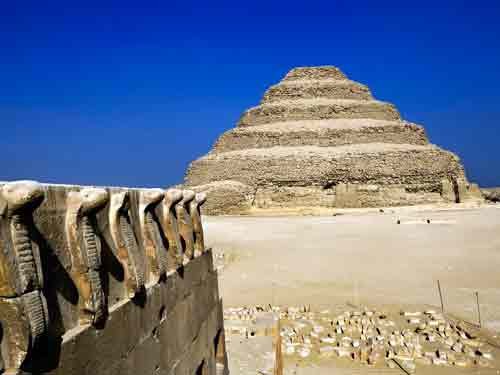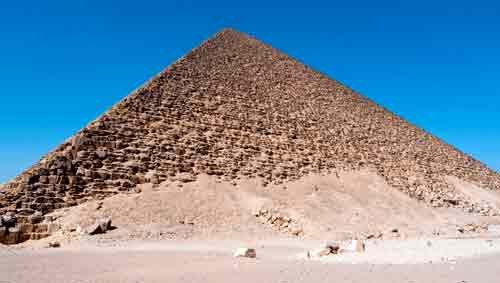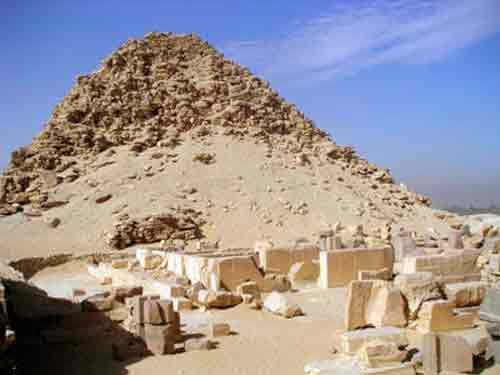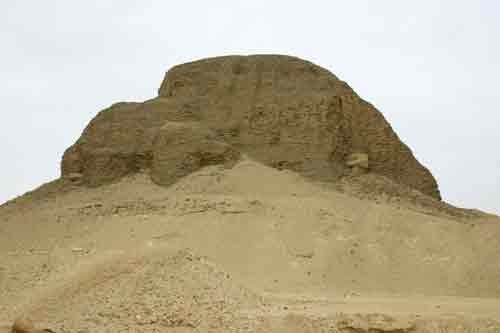The Pyramids Of Egypt
History of pyramids of Egypt with the construction of the first pyramid of Ancient Egypt – step pyramid of Pharaoh Djoser. It was built in Saqqara around 2,600 BC, but It was a Pharaoh of the third dynasty.

To him the tombs of the pharaohs were built from dried bricks. Subsequently they received the name – emphasised. This emphasised was built for Djoser.
But Pharaoh took advantage of this tomb, and together with his talented architect Imhotep undertook the construction of the Grand mastaba at Saqqara, which is now called pyramid of Djoser or step pyramid. On this bottom emphasised built five more mastabas, each smaller size. Construction took place in six stages, the number of steps. The base of the pyramid as a result of add-ins reached the size 125х115 meters and a height of 61 meters (the height of the modern twenty-storey building).
Here for the first time as a building material have already been burnt brick, and stone. The pyramid of Djoser is considered to be the world's first stone structure.
In the third dynasty was erected several stepped pyramids of smaller size. These ancient Egyptian pyramids are in the mid to Upper Egypt, mostly they were only ruins.
Only the first Pharaoh of the fourth dynasty, Sneferu pyramids of ancient Egypt acquired its final form.
The first thing Sneferu rebuilt the pyramid in Medumi.
Pyramid in Madame

In Meduma pyramid was built for Pharaoh-Hoon, the last ruler of the third dynasty. It is called the most unusual of all the Egyptian pyramids because of the irregular shape. Initially, the same as the pyramid of Djoser, it was speed. Its height has already reached 94 meters and a half times more of the step pyramid at Saqqara.
Consisted of 7 steps, of which only 3 are visible. Built of limestone blocks. Sneferu has expanded and increased the pyramid, added the 8-th step and added to the horizontal side walls, which transformed the monument into the first "true" pyramid.
This pyramid at the end of the construction was covered with a beautiful veneer.
Later, there was a natural or man-made destruction of the outer layers, which led to typical now the shape of a pyramid.
Presumably, the original height of the pyramid Medumi was even bigger and reached 118 meters with the base 144х144 meters.
The entrance to peermedu is the lowest public layer about 20 meters above the ground. It was discovered in 1882. In the chamber of the sarcophagus was not, they found some fragments of a wooden coffin, which in its style belonged to the era of the old Kingdom.
For a long time, the internal structure of Medumi pyramid seemed to be the simplest of all known. Was known only to a single corridor in the pyramid, which began on the North side and abruptly down into approximately 7 m below the base, where it expands, turning into two horizontal "hallways". The entrance to the burial chamber is located exactly below the top of the pyramid. This entry, unlike all other pyramids leads to the camera not to the side or from above but from below, through a hole made in the floor.
It would seem, more than anything inside the pyramid there. However, in 2000, a French expedition had a large study, which was discovered another camera and an indoor corridor, passing almost parallel to the known.
Egyptologists never found out, for some reason Sneferu abandoned the stepped shape, and began to build a very impressive size of the pyramid a new configuration having no step, and the smooth side faces, and is called therefore "proper". In comparison with the creation of Sneferu, the step pyramid of the third dynasty began to look like rural outbuildings.
Bent pyramid

If Sneferu in Dahshur was built by the "bent pyramid". This name is because its walls are at a height of about 45 meters change the tilt to 10 degrees.
This is one of the most mysterious pyramids of Ancient Egypt. It is called the South due to the location in the South relative to the other, "broken", "cut" or "diamond" for its irregular shape.
She, like all the Egyptian pyramids, the entrance is located on the North side. It is provided by the religious beliefs of the Egyptians. However, there is something that distinguishes the zigzag pyramid is the second entrance. It somehow leads to the pyramid on the West side. The North entrance was built much earlier than the Western, and the origin of the second entrance not solved until now. The second mystery of the pyramid — the absence of the sarcophagus in its interior chambers. After reading the inscriptions made in two places, the pyramid and the stele in the interior, was established that it belongs to Pharaoh Snofru.
There are many theories as to why the pyramid has an irregular shape. Assume that Snofru death occurred suddenly, when there was completed the pyramid. To accelerate terms of construction, the builders decided to change the angle of inclination. There is a hypothesis that during this time built two pyramids: one here, another in Meduma, then the construction in Meduma possible violation occurred technology, and the pyramid collapsed. This incident forced to hastily change the angle of the sides of the pyramid in Dahshur, when she was already half-built.
It is believed that Broken pyramid its original appearance has changed in the earthquake, or the design is sunk from the surface on which it is located, or due to the presence of voids in the earth's crust, etc.
Pink pyramid

Pink pyramid is the largest of the three large pyramids of the necropolis Dahuricae. It is sometimes called the Red pyramid. The name is associated with the color of stone blocks, acquiring in the sunset pink or reddish color. The pyramid is another name of Northern, the location in relation to other pyramids Dahshur. This pyramid is attributed to Sneferu, as his name was discovered, inscribed with red paint on several blocks of skin.
Pink pyramid is the third highest pyramid in Egypt, after the pyramids of Khufu and pyramid of Khafre at Giza. At the time of its construction in the XVII century BC, it was the tallest building on Earth.
Then it was not pink, because its walls were covered with white limestone. Much of this limestone in the Middle ages were removed to build houses in Cairo, resulting in exposing a pinkish limestone.
Pink pyramid is considered the world's first successful attempt to build a "real" isosceles pyramid. It has the correct stereometric pyramidal shape, although the angle of its sides is 43° 22' compared to the norm later in 51° 52'. She has an extremely low slope of the walls (base 218,5 x 221,5 m at a height of 104.4 m).
It is in vain Pink pyramid is in the shadow of the great pyramids on the Giza plateau. Size it's slightly inferior, but the perfection of its performance is not worse. It happened largely by coincidence, not because of its parameters and properties. Long Pink pyramid was in the territory of the military base, access to it was forbidden, and only after 1997, when the military base was slightly shifted to the side, access to the pyramid received the archaeologists and tourists.
In the history of the construction of the Egyptian pyramids Pharaoh Sneferu left a bright trail!
He was the only one (not counting amenemhat III, Pharaoh of the XII dynasty), who built two pyramids at the same time – both nearly twice the height of the pyramid of Djoser – Houndstooth and Pink in Dushore. Some researchers ascribe to him the authorship and Medumi pyramid, in this case its share will have three very impressive pyramid!.. So the span of its construction in any case exceed the scale of its more famous son, Khufu (Cheops).
The great pyramid

However, still more than three famous Pharaoh of the old Kingdom, Sneferu from inheriting the throne of Egypt: Khufu (Greek name Cheops), khafra (Greek Chephren) and menkaure (Greek – Mikerin), which is attributed to the consistent construction on the Giza plateau the three largest pyramids in Egypt.
The construction of the pyramids, attributed to the fourth dynasty, impresses with its scale. Three-quarters of all materials consumed in Egypt the construction of pyramids in history, went to the construction of the pyramids of this dynasty, and that according to some estimates, more than 20 million tons!
The perfection of the three pyramids on the Giza plateau – the great pyramid – still amazes researchers. Affect not only the structures but also the parameters of design and quality of construction.
To be precise, the third of the Giza pyramids, the pyramid of menkaure is not one of the biggest. Houndstooth and Pink in Dushore pyramid, the pyramid in Meduma more of her, but together with the other pyramids of Giza seems to be a very large.
The pyramids of the pharaohs of the V and VI dynasties
The pharaohs of the V and VI dynasties of pyramid building continued, although such Grand buildings as the lords of the fourth dynasty, not built. These pyramids in its size was less than half the huge tombs of Cheops and Chephren. Much worse was the quality of construction.
The founder of the V dynasty Pharaoh Userkaf built his pyramid at Saqqara, near the pyramid of Djoser, which in those days was a sacred place already of immemorial antiquity. His successors, the pharaohs Sahur, Neferirkare and Nauser their pyramids were built closer to Giza, near today's Abusio

Layout abyysky pyramids were the same, the most well-preserved complex of pyramid of Pharaoh Sahur. The dimensions of his pyramid was originally as follows: length of the base – 70 m, height 50 m. Now the height of the pyramid is only 36 m.
Last Pharaoh of the V dynasty Unis again moved his tomb in Saqqara. His little pyramid (the length of the sides of the base 67 m, width 44 m, respectively 57,5 today and 19 m)

Of all the pyramids of the kings of dynasty V pyramid of Unis, the smallest. Apparently, the power of Pharaoh during his reign weakened.
On the East side of the pyramid remains of the mortuary temple.
Now the pyramid of Unis badly damaged – the walls are eroded, apex rounded, base littered with fallen blocks.
Its interior, in spite of severe destruction of the pyramid, are in good condition and available for inspection. To enter the pyramid you a passage which carried the deceased Pharaoh to a place of eternal rest, not through the tunnel the robbers.
The pyramid of Unis is considered a valuable monument of the old Kingdom.
Before it is not considered necessary inside of pyramids to immortalize mortuary spells Unis for the first time commanded inside the pyramid to carve an entire set of spells designed to blagodenstviya and to protect the king in the afterlife.
Endless columns of inscriptions made the most beautiful green-blue hieroglyphs, from top to bottom cover to the chamber walls and the "front", and a gable ceiling dotted with green and blue stars.
The layout of the pyramid of Unis was repeated in the other pyramids of the VI dynasty, but their quality of construction is worse.
The last significant architectural monument of the old Kingdom was the pyramid of Pharaoh Piopi II in the southern part of Saqqara. Its height is 52 m, the edge length is 78 m.

The pyramid is built of very large stone blocks. After the construction of the sixth stage stoned limestone plates, the remains of which can be seen among the fallen and lying at the base of the debris of the upper layers. Underground chamber different from the chambers of the pyramid of Unis only its color. In the ceiling a gaping done by ancient robbers big hole, however, the wall texts and the sarcophagus is well preserved.
During the "first transition period" only one was constructed a small pyramid. It was a pitiful semblance of the magnificent pyramids of the heyday of the old Kingdom.
Pharaoh IBI began the construction of the pyramid, but it remained unfinished. Its ruins are located near the complex of the pyramid of the Pharaoh Piopi II. The pyramid of IBI was the size of a base 31X31 m (now 21X21 m). Its height, as might be expected, reached only 20 m. side of the pyramid was not oriented to the cardinal points. In the burial chamber were discovered the traces abbreviated "texts of pyramids".
The pyramids of the Middle Kingdom
The kings of the twelfth dynasty of the Middle Kingdom continued to build pyramids. They began to build them South of Saqqara, not far from today's List, Dashur and Filmscore oasis.
Remained unchanged the design of the complex of the pyramid: the lower temple, ascent, mortuary temple, pyramid and pyramid companion. However, the internal structure of the pyramid was different. The entrance to the pyramid of the Pharaoh of Sinusita II is located on the South side.

The Pharaoh broke the ancient tradition, his successors also ceased to follow the ancient custom of the orientation to the North, toward the Polar star.
The last great Pharaoh of the Middle Kingdom Amenemhat III built two pyramids, one in Gavar, the second – in Dushore. The first had a height of 58 m when the length of the base side 101 m. the Pyramid rose Meridova on the shore of the lake, which was much deeper than it is now. Interest is the burial chamber of the Pharaoh. It was carved into the rock, which formed the core of the pyramid.
Life pyramids
During the "second transition" some pharaohs built pyramids. Pharaoh Ginger (XIII dynasty) built his tomb is the southern part of Saqqara. His pyramid like a pyramid of amenemhat III at hawara, but for its size it is less than half (base 55х55 m, height of 37.7 m). The tomb of the Pharaoh is also made from a quartzite monolith.
The last Egyptian Pharaoh who built the pyramids, was probably Ahmose I, the first ruler of the New Kingdom, liberated the country from the yoke of the Hyksos. The burial of Ahmose I has been found yet, but we are aware of his symbolic tomb in Abydos, it has the shape of a pyramid.
The pharaohs of the New Kingdom built tombs.
In the New Kingdom, the pyramids have become a part of the decoration of private tombs and graves. The most beautiful of these tombs were discovered by archaeologists in the cemetery of the artisans in Deir El-Medina, near Thebes.
No doubt these little pyramids that adorned the upper part of the tomb was connected with the cult of the Sun God. On the Eastern slope of the pyramid was arranged a small alcove, which housed the cult statue of the occupant of the tomb. She looks towards the rising sun. Above the burial chamber, carved in the rock, was situated a small courtyard. He was surrounded by a stone wall. The West side was built a small oratory in the form of a terrace with columns. Above all this stood a small pyramid with a base of 3X3 meters, height-4 m. The angle of inclination to the horizontal plane was much more vertical than the huge pyramids of the Ancient and Middle Kingdom, it reached 68 °.
The pyramid was revived in VIII—VII centuries BC, but not in Egypt, and in the territory of the Nubian Kingdom of Napata and in the IV century BC, Meroe. None of these pyramids did not have the length of its base more than 12-13 m and a height of more than 15-16 m. the Angle of the faces was equal to 68 °, and on the tombs of the Theban craftsmen. They are built mainly of stone, is only the most recent were built of bricks.
Source: https://ru.wikipedia.org/wiki/%D0%95%D0%B3%D0%B8%D0%BF%D0%B5%D1%82%D1%81%D0%BA%D0%B8%D0%B5_%D0%BF%D0%B8%D1%80%D0%B0%D0%BC%D0%B8%D0%B4%D1%8B